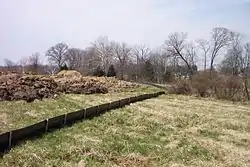
A sediment control is a practice or device designed to keep eroded soil on a construction site, so that it does not wash off and cause water pollution to a nearby stream, river, lake, or sea. Sediment controls are usually employed together with erosion controls, which are designed to prevent or minimize erosion and thus reduce the need for sediment controls. Sediment controls are generally designed to be temporary measures, however, some can be used for storm water management purposes.[1]
Commonly used sediment controls

- Check dam
- Diversion dike (temporary)
- Fiber rolls
- Gabions
- Siltbusters
- Sand bag barrier
- Sediment basin
- Sediment trap
- Silt fence
- Storm drain inlet protection
- Straw bale barrier
- Turbidity curtain[2]
Active treatment systems
Chemical treatment of sediment, commonly called an active treatment system, is a relatively new form of sediment control for the construction industry. It is designed to reduce turbidity in nearby water bodies and involves collection of sediment-laden stormwater in a basin or tank, and adding a chemical flocculant. An example video of chemical dosing on slow settling solids is on YouTube.[3] This causes the sediment to settle so it can be more easily removed from the water. Some of the flocculent chemicals used for sediment treatment are chitosan and polymers such as polyacrylamide. The water is then pumped through a removal system, such as a Siltbuster, sand or cartridge filter, prior to discharge. Chemical sediment control is currently used on some construction sites around the United States and Europe, typically larger sites where there is a high potential for damage to nearby streams.[4]
Another active treatment system design uses electrocoagulation to flocculate suspended particles in the stormwater, followed by a filtration stage.[5]
Regulatory requirements
All states in the U.S. have laws requiring installation of erosion and sediment controls (ESCs) on construction sites of a specified size. Federal regulations require ESCs on sites 1 acre (0.40 ha) and larger. Smaller sites which are part of a common plan of development (e.g. a residential subdivision) are also required to have ESCs.[6] In some states, non-contiguous sites under 1-acre (4,000 m2) are also required to have ESCs. For example, the State of Maryland requires ESCs on sites of 5,000 sq ft (460 m2) or more.[7] The sediment controls must be installed before the beginning of land disturbance (i.e. land clearing, grubbing and grading) and must be maintained during the entire disturbance phase of construction.
See also
- Certified Professional in Erosion and Sediment Control (CPESC)
- Geotechnical engineering
- Geotextile (material used in erosion & sediment controls)
- Nonpoint source pollution
- Stormwater
- Universal Soil Loss Equation
References
- ↑ Basic Erosions and Sediment Control. Virginia Department of Conservation and Recreation. 2010.
- ↑ State of Washington. Department of Ecology. Olympia, WA. “Stormwater Management Manual for Western Washington.” Volume II –Construction Stormwater Pollution Prevention. 2005.
- ↑ Example video of chemical dosing on slow settling solids
- ↑ California Stormwater Quality Association. Menlo Park, CA. “California Stormwater BMP Handbook: Chemical Treatment.” Fact Sheet No. SE-11. January 2003.
- ↑ Benedict, Arthur H., et al. 2004. "Raising the Bar on Construction Stormwater Treatment." Stormwater: May–June 2004.
- ↑ United States Environmental Protection Agency (EPA). “Regulations for Revision of the Water Pollution Control Program Addressing Storm Water Discharges; Final Rule” (Commonly called the “Phase II Stormwater Rule.”) Federal Register, 64 FR 68721, December 8, 1999.
- ↑ State of Maryland. Code of Maryland Regulations (COMAR). Activities for Which Approved Erosion and Sediment Control Plans are Required. Sec. 26.17.01.05.
External links
- Siltbuster - a UK rental company of Lamella Clarifiers for the construction industry.
- Erosion Control - a trade magazine for the erosion control and construction industries
- International Erosion Control Association - Professional Association, Publications, Training
- “Developing Your Stormwater Pollution Prevention Plan: A Guide for Construction Sites.” - U.S. EPA